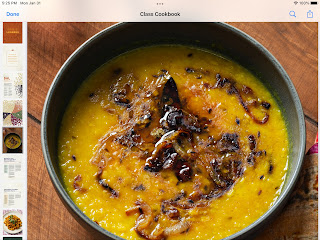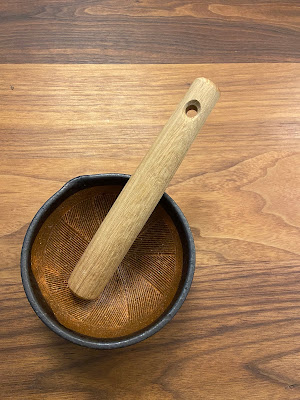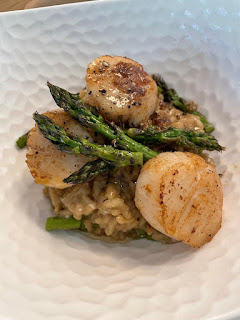"What really“distinguishes Indian food is its magical use of spices. Some came from Egypt. Some came from the New World. But we use them like a painter uses colors."
Menu
❧
Dani Puri Chat with Green Sauce and Tamarind Chutney
Moong Dal and Red Lentil
Butter Chicken with Plain Basmati
Chapati
Raita
Baked Lamb Shami Kebobs
Okra with Shallots
Cucumber and Tomato Salad
A rich and mellow Indian Pale Ale from a California brewery, Lagunitas, filled in beautifully for an Indian beer, which was sadly missing from our local stores.
Dahi Puri Chaat with Green and Tamarind Chutneys ❧ Caroline
Moong Dal and Red Lentils with Browned Onions
Caroline
1 cup split red lentils (masoor dal)
5 cups water
1/2 teaspoon ground turmeric
1 1/2 teaspoons salt
4 tablespoons ghee, clarified butter, or vegetable oil
Generous pinch asafetida
1 teaspoon whole cumin seeds
3 - 5 dried red chiles
1 small onion, cut into thin rings
Put the oil into a small frying pan and set the pan over medium-high heat. When hot, put in the cumin seeds. Let them sizzle for 10 seconds. Add the asafoetida and, a second later, the red chillies. Stir for 5 seconds or until the chillies darken. Now add the onion. Stir and fry for 2 minutes. Turn the heat to medium-low and cook, stirring, for another 2 minutes or until the onions turn brown and crisp. Pour the contents of the pan evenly over the surface of the beans. Serve immediately. (The whole red chillies add flavour and are decorative, but should be nibbled at only by those who know what they’re in for.)
Butter Chicken with Plain Basmati ❧ Kaarina
I prefer milder spicing so I chose the much-loved classic, Butter Chicken, a curry from Northern India, as my main dish to prepare along with plain basmati rice, chapati flat bread and a cooling raita - a yogurt, garlic and cucumber condiment.
Ingredients
4 tablespoons tomato paste
1 cup water
1 teaspoon grated ginger
1 cup heavy cream
1 teaspoon garam masala
¾ teaspoon salt
¼ teaspoon sugar
1 fresh hot green chili, such as bird’s eye, finely chopped
¼ teaspoon cayenne pepper, or a similar red chili powder, such as hot paprika
1 tablespoon finely chopped fresh cilantro
4 teaspoons lemon juice
1 teaspoon roasted cumin powder
1 stick unsalted butter
4 servings leftover boneless tandoori-style chicken (or store-bought)
Combine the tomato paste and water in a large glass measuring cup. Whisk to combine, then add the ginger, heavy cream, garam masala, salt, sugar, green chili, cayenne, cilantro, lemon juice, and cumin. Stir well to incorporate.
Add the chicken to the pan. Turn it often so that it becomes coated in the sauce. To serve, transfer the chicken to a warm serving platter and spoon extra sauce over the top.
Plain Basmati Kaarina ❧ Kaarina
Raita ❧ Kaarina
5-inch cucumber
2½ cups full-fat plain yogurt
2 tablespoons finely chopped fresh mint leaves
½ teaspoon cumin seeds, ground in a mortar and pestle or spice grinder (or ½ teaspoon ground cumin powder)
¼ teaspoon cayenne pepper
Salt and pepper to taste
Method
In a separate bowl, whisk the yogurt until it’s smooth. Add the cucumber, mint, cumin, and cayenne pepper, and season the raita with salt and pepper. Mix. Keep it in the refrigerator, covered, until ready to use.
Baked Lamb Shami Kebobs ❧ Diane
***
2 medium onions, divided: 1 thinly sliced into rings and 1 finely chopped
2 to 3 fresh hot green chilies, such as bird’s eye, destemmed and finely chopped
1 handful fresh mint leaves, chopped (about 5 tbsp), plus a few sprigs for garnish
1 1⁄2 tbsp lemon juice
Salt to taste, plus 1 tsp
4 tbsp blanched, slivered almonds
2 tbsp white poppy seeds
1 lb ground lamb (twice-ground if possible)
1 tsp ground cumin
1 tsp garam masala (see page 13)
1⁄4 tsp cayenne pepper 3 tbsp plain yogurt
1 tbsp unsalted butter, for greasing
1. Submerge the onion rings in a bowl of ice water. Cover the bowl with plastic wrap, and keep it in the refrigerator until ready to serve, for 1 to 5 hours.
2. In a separate bowl, combine the chopped onion, green chilies, mint, and lemon juice. Season with salt, and stir to combine. Set aside for at least 20 minutes to allow the flavors to meld.3. Heat a small skillet or frying pan over medium-high heat. Toast the almonds until they are golden brown, shaking the pan or stirring occasionally, about 3 to 4 minutes. Transfer the toasted almonds to a plate or bowl, and let them cool.
4. Return the pan to medium heat, and toast the poppy seeds until they turn a shade darker, 1 to 2 minutes. Transfer the poppy seeds to a small bowl, and let them cool.
5. Using a clean coffee grinder or spice grinder, grind the almonds until they are a finepowder, and empty the powder into a large bowl. Repeat with the poppy seeds, and add the powder to the almond powder. Add the lamb, cumin, garam masala, cayenne, yogurt, 1 teaspoon of salt, and the reserved onion-mint mixture. Use your hands or a wooden spoon to combine all of the ingredients together, kneading the mixture into a ball.
6. Preheat the oven to 350°F.
7. Grease the bottom and sides of an 8-by- 8-inch baking dish with the butter. Transfer the meat to the center of the dish, then flat- ten it so that it reaches the edges. Pat it into an even layer with your fingers.
8. Place the baking dish in the oven and bake for 50 minutes. After 50 minutes, remove the dish and carefully drain off any liquid that has accumulated. Return the dish to the oven. Turn the oven to the broil set- ting, and grill until the top of the patty is crispy, about 1 minute.
9. Take the onion slices out of the refrigerator, drain them, and place them on a clean kitchen towel. Gather the edges of the towel together and twist to drain any excess water from the onions.
10. To serve, slice the lamb patty into 1-inch squares and arrange them on a platter or plate, then top with the chilled onions and the reserved sprigs of mint.
Okra with Shallots ❧ Diane
I'm not a big fan of okra - especially when it is slimy. This version was scrumptious as the okra tended more to crispy. The key was to keep them dry before cooking.
Ingredients
12 oz fresh okra pods, stems and tips removed
1⁄4 cup olive oil, canola oil, or peanut oil
1⁄2 tsp cumin seeds
3 large shallots, halved lengthwise and sliced into thin half-moons (about 3⁄4 cup)
11⁄2 tsp ground coriander
1⁄4 tsp crushed red pepper flakes
1⁄2 tsp salt
1 tsp lemon juice
This recipe calls for cooking the okra with shallots. Small shallots are used widely in South Indian cuisine, but if you can’t track down small shallots, Madhur advises using three bulbs of the larger European varieties available in many markets.
Method
1. Slice each okra on the bias into 3 to 4 pieces, and transfer the pieces to a medium bowl.
2. Warm the oil in a frying pan or skillet over medium-high heat. Once the oil begins to shimmer, add the cumin seeds. Let sizzle for a few seconds, then add the sliced okra. Stir to combine, and sauté for about 5 minutes.
3. Add the sliced shallots, and continue to fry until the shallots have picked up a little color, about 3 minutes.
4. Reduce the heat to low and add the coriander, red pepper flakes, and salt. Stir to incorporate, and stir-fry for 7 to 9 min- utes, until the okra is crispy and tender. Add the lemon juice, and mix well to com- bine. Taste, and adjust the seasoning as preferred.
2 medium cucumbers, such as Kirby, or 1 large English cucumber
1⁄8 tsp cayenne pepper
1⁄3 tsp roasted cumin powder (see page 14)
2 tbsp olive oil or peanut oil
1⁄4 tsp whole brown mustard seeds
8 to 10 fresh curry leaves
A tadka, the Indian technique of cooking a mixture of spices in fat to release their essential oils, is used to season dishes from dals to salads.
This simple tomato and cucumber salad is topped with a two-ingredient tadka—one made with mustard seeds and curry leaves. Be patient and attentive while making your tadka; the mustard seeds will have reached optimum flavor when they stop sputtering in the hot oil, and the curry leaves should be translucent and curled.
Method
1. Peel the cucumbers and cut them into quarters, first halving them crosswise and then halving each section lengthwise. Ar- range the quartered cucumbers on a plate with the tomatoes. Drizzle the vegetables with lemon juice, and then season with salt, a few grinds of black pepper, and the cayenne pepper. Sprinkle the roasted cumin powder over the top.
2. Heat the oil in a small saucepan or skillet set over medium-high heat. Once the oil is hot, add the mustard seeds. When the seeds begin to sizzle and pop, add the curry leaves and cook until the leaves are glossy, a few seconds more. Remove the oil from the heat, and pour it over the cucumbers and tomatoes. Serve immediately.















































